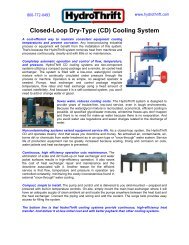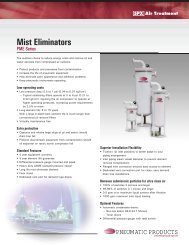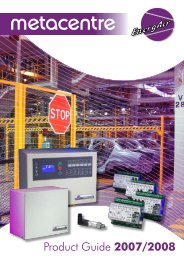Engineering for Safe Chlorine Disinfection - INSCO Group
Engineering for Safe Chlorine Disinfection - INSCO Group
Engineering for Safe Chlorine Disinfection - INSCO Group
Create successful ePaper yourself
Turn your PDF publications into a flip-book with our unique Google optimized e-Paper software.
<strong>Engineering</strong> <strong>for</strong> <strong>Safe</strong> <strong>Chlorine</strong> <strong>Disinfection</strong>by Harland R. Pond, Product Manager; Grundfos Pumps Corp.For more than 75 years chlorine has been effectivelyused to disinfect drinking water, eliminatingdangerous bacteria and toxic compounds. Water supplyengineers and treatment facility operators are used tonecessary risks and problems associated with chlorinedisinfection in order to deliver safe water.Typically three methods are used to apply chlorine:1. <strong>Chlorine</strong> gas dosing2. Dosing of sodium or calcium hypochloritesolution3. Electrolytic chlorine generationThese methods present a variety of risks and issues.<strong>Chlorine</strong> gas applications involve managing risksassociated with accidental releases and contact with thedangerous gas. Dosing hypochlorite solutions requirehandling concentrated and dangerous chemicals, usuallyin bulk quantities. Beyond managing safety, operatorsoften face operational issues such as off-gassing ofliquids, degradation of the product, calcification wheninjecting and equipment failures. Managing these issuesadds operational and capital costs <strong>for</strong> drinking waterinstallations.Treatment facilities often turn to sodium hypochlorite todeliver disinfection results and mitigate risks.Electrolytic chlorine generation is an alternative methodto apply sodium hypochlorite <strong>for</strong> disinfection, offeringunique benefits <strong>for</strong> operations. Electrochlorination usescommon raw materials – salt, water and electricity – togenerate a low strength sodium hypochlorite solution (upto 0.8% concentration) on site. Installed generationequipment includes a brine storage tank, the actualelectrogenerator and a final product solution tank fromwhich the sodium hypochlorite is dosed.Electrochlorination helps relieve operators of multipleconcerns associated with otherdisinfection methods. Operators only store andhandle common salt, eliminating the risks ofhandling dangerous chemicals. The final product,while still effective sodium hypochlorite, does notdegrade as readily as stronger concentrations,allowing <strong>for</strong> on-demand service and reducingcalcification of injection points. The generatorsalso operate on demand, eliminating bulk storageof chemicals.In electrolytic generation of chlorine, a brinesolution is passed over a series of electrodes in anelectrolytic cell. DC power is applied to theelectrodes, resulting in the generation of sodiumhypochlorite. Hydrogen gas is produced as a byproduct,and must be safely managed. (SeeFigure 1).NaCl +H 2 O-CathodeH 2NaClONaOHNaClOsolutionCl 2+Na + NaCl Cl -H + H 2 O OH -AnodeFigure 1. The electrolytic generation of sodiumhypochlorite using a brine solution.This presents several issues with generatingequipment. Often equipment is complicated anddifficult to use or fix. Capital equipment andreplacement parts are often expensive. And thegeneration of hydrogen gas requires specialequipment to dilute and vent it to theatmosphere to keep the concentration below
<strong>Engineering</strong> <strong>for</strong> <strong>Safe</strong> <strong>Chlorine</strong> <strong>Disinfection</strong> GRUNDFOS WHITE PAPER | 24 percent (the Lower Explosion Limit of LELthreshold). Most installations require special dilutingequipment and explosion-proof designs <strong>for</strong> therooms to ensure safety. All equipment in thispotentially explosive atmosphere must meet strictdesign requirements to prevent sparks. This addsinstallation and risk costs.Operators and engineers must look <strong>for</strong>electrochlorination equipment engineered tomaximize the value and reduce the risks. The key toadding value in a water plant is to simplifyengineering and controls and make the unit safe andreliable – all while keeping an eye on the total cost ofoperation.Ideal systems provide safe and simple operation,making start-up and ongoing maintenance easy.Inherent and interlocked safety features are a mustbut the unit must help manage total operationalcosts. (See Figure 2)One key area of focus is in the handling of hydrogengas. Electrochlorination generator designs may look<strong>for</strong> ways to eliminate the need <strong>for</strong> explosion- proofzones and equipment. The vertical cells permit freerelease of hydrogen without accumulation inherentto horizontal cells. Also engineers should look <strong>for</strong> celland degassing column enclosures with <strong>for</strong>ced airventilation to ensure any leaks stemming from poormaintenance or mechanical failure are diluted. <strong>Safe</strong>tyinterlocks must ensure that the integrity of thesystem is maintained at all times. Finally, any systemmust feel safe to cut power to the cell if any unsafeconditions are detected.Onsite electrochlorinators offer safe and effectiveapplication of sodium hypochlorite while reducingtotal facility costs and risks compared to othertechnologies. With the right engineering this canenable treatment engineers and operators to focuson delivering clean, safe water <strong>for</strong> their communities.Figure 2. Electrochlorination generator with verticalgeneration cell (left column), degassing column(right) and integrated air flow handling system(bottom left).
www.grundfos.us
















